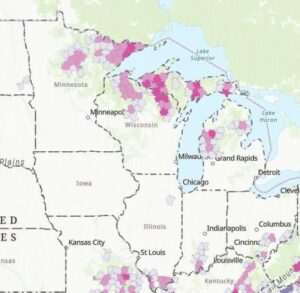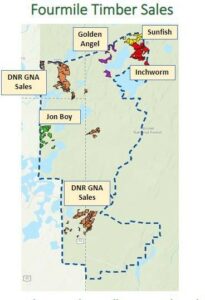July 21, 2023
Conservation of Mature and Old Growth Forests
Mature and old-growth forests – including those in the Midwest’s Northwoods – play a crucial role in reducing the impacts of climate change by capturing and storing carbon emissions. These trees are essential to a safe and sustainable future, but they need our help now more than ever
Despite President Biden’s order to protect them, over 370,000 acres of mature and old-growth forests are currently at risk of being logged, including the Chequamegon-Nicolet in northern Wisconsin.
The US Forest Service recently had a public comment period where ELPC weighed in on why we need to protect mature and old-growth forests. You can read our comments here or below.
***
Director
Policy Office
United States Forest Service
201 14th Street NW
Mailstop 1108
Washington, DC 20250-1124
Re: Public Comment on Conservation of Mature and Old-Growth Forests
The Environmental Law & Policy Center (ELPC) appreciates this opportunity to provide comment on the Advance Notice of Proposed Rulemaking (FS-2023-0006-0002) addressing “how should the Forest Service adapt current policies to protect, conserve, and manage the national forests and grasslands for climate resilience, so that the Agency can provide for ecological integrity and support social and economic sustainability over time.” ELPC is the Midwest’s leading environmental legal advocacy and sustainability innovation organization. ELPC’s staff work across Midwest Great Lakes states.
ELPC has also joined comments submitted by members of the Climate Forest Coalition. We submit these additional comments to address two core questions posed in the Advance Notice of Proposed Rulemaking (ANPRM) and specifically show how the Fourmile Vegetation Management project in the Chequamegon- Nicolet National Forest (CNNF) demonstrates why a strong rule is urgently needed.
The responses in these comments address two core questions posed in the Advance Notice of Proposed Rulemaking (ANPRM):
- How should the Forest Service adapt current policies and develop new policies and actions to conserve and manage the national forests and grasslands for climate resilience, so that the Agency can provide for ecological integrity and support social and economic sustainability over time?
- How should the Forest Service assess, plan for and prioritize conservation and climate resilience at different organizational levels of planning and management of the National Forest System
( e.g., national strategic direction and planning; regional and unit planning, projects and activities)?
ELPC proposes that the US Forest Service can best reach these goals by protecting remaining mature and old growth forests for climate security and biodiversity heritage, enacting robust environmental review to assess carbon impacts of logging projects, and respecting the treaties and deepening consultation with American Indians regarding stewardship of national forests and grasslands.
Here are our key answers to these questions, supported further in these comments:
- To slow climate change, we need a permanent rule to protect remaining mature and old-growth forests from further logging.
- To preserve our options for the future, however, USFS cannot wait for the rule to be finalized, or worse, wait for Land and Resource Plans at the various National Forests to be amended to conform to the rule. The USFS must pause logging of remaining mature and old-growth forests on National Forests now while rulemaking, possible litigation, and formal forest planning continue.
- USFS should reevaluate the Records of Decision for logging projects approved in the “lame duck” period following the 2020 election and before the new president was inaugurated on January 20, 2021, especially the Fourmile Project in the CNNF.
- The Forest Service can best assess, plan for and prioritize conservation and climate resilience by reckoning with the entrenched logging-centric culture at the Forest Service that is also at odds with current climate science. Without far-reaching reform of current practices and a pause in climate- harmful projects, the Forest Service is undermining the very goals of this ANPRM. The Forest
Service must ensure that “at different organizational levels of planning and management” the Administration’s policies are being carried out. That is not the case today.
Protecting Remaining Mature and Old Growth Forests
By now, it has become clear that protecting and conserving mature and old-growth forests is vital to mitigating climate change that increasingly inflicts disruption and harm on populations worldwide. Scientific findings from the Forest Service and others have proved that mature and old-growth forests are key to carbon capture and sequestration. Numerous statements from President Biden, USDA Secretary Tom Vilsack and USFS, itself, recognize the need to conserve our remaining mature and old-growth forests.
President Biden clearly stated in Executive Order 14072, Strengthening the Nation’s Forests, Communities, and Local Economies, issued April 22, 2022:
Globally, forests represent some of the most biodiverse parts of our planet and play an irreplaceable role in reaching net-zero greenhouse gas emissions. Terrestrial carbon sinks absorb around 30 percent of the carbon dioxide emitted by human activities each year. Here at home, America’s forests absorb more than 10 percent of annual United States economy-wide greenhouse gas emissions. Conserving old-growth and mature forests on Federal lands while supporting and advancing climate-smart forestry and sustainable forest products is critical to protecting these and other ecosystem services provided by those forests.
USDA Secretary Tom Vilsack similarly spoke of the scientific fact that mature and old-growth forests provide climate sequestration we so desperately need in his June 23, 2022 Secretary’s Memorandum 1077-004.
In addition to these vital benefits, our forests are climate change mitigation powerhouses. Attaining our global climate goals cannot be achieved in the absence of investments and policies to secure healthy and climate resilient forests.
The very premise of this advance notice of proposed rulemaking (ANPRM) acknowledges “the importance of Mature and Old-Growth (MOG) forests on Federal lands for their role in contributing to nature-based climate solutions by storing large amounts of carbon and increasing biodiversity.”
Yet, despite these clear statements of policy, USFS is actively logging known mature and old growth trees on the National Forests now, and apparently intends to continue, or even accelerate, that process. That is why a permanent MOG rule is necessary. Little else is likely to change USFS practices at the Forest and District levels.
Fourmile as an Example of Why a Permanent MOG Rule is Badly Needed
The experience with the Fourmile Vegetation Management project in the Chequamegon-Nicolet National Forest (CNNF) makes very clear the urgent need for the rulemaking process now underway. This project demonstrates the great lengths that Forest managers will go to avoid confronting climate change and biodiversity issues. CNNF repeatedly used outdated climate guidance, rushed to finalize the project decision before President Biden was sworn in, and continue to log mature stands in defiance of new federal policy and the goals of this rulemaking.
makes very clear the urgent need for the rulemaking process now underway. This project demonstrates the great lengths that Forest managers will go to avoid confronting climate change and biodiversity issues. CNNF repeatedly used outdated climate guidance, rushed to finalize the project decision before President Biden was sworn in, and continue to log mature stands in defiance of new federal policy and the goals of this rulemaking.
The Fourmile project is in northeastern Wisconsin, in the Eagle River – Florence District of the CNNF. The project area and surrounding lands encompass some of the highest quality ecological systems and habitat types in the CNNF. Fourmile includes high- value interior hardwood forest providing excellent candidate areas for restoration of large patches of mature and low disturbance interior forest.
The northern portion of the project area includes rare, high quality interior northern hardwood forests and other important forest types (e.g. natural origin pine) with relatively higher levels of hemlock regeneration than found elsewhere in the CNNF. On richer sites, rare old-growth hemlock, yellow birch, and white pine remnants occur with associated plant and animal species and high-quality aquatic features.
The Fourmile project includes more than 12,000 acres of logging, 1.2 miles of new road construction, 46.4 miles of road reconstruction, and other intensive management activities in the CNNF. Fourmile embodies Trump Administration policies to ignore climate change and to rapidly increase logging, by 72% in 5 years, and to do so with only limited environmental review.
reconstruction, and other intensive management activities in the CNNF. Fourmile embodies Trump Administration policies to ignore climate change and to rapidly increase logging, by 72% in 5 years, and to do so with only limited environmental review.
As the recently released USFS Forest inventory shows, The Fourmile Project is located in a key area for mature and old growth in the national forests in the Midwest. Northeast Wisconsin hosts an abundance of mature forest, forming a corridor running north into Michigan’s Upper Peninsula and the Ottawa National Forest, providing wildlife and biodiversity benefits.
Because this is, apparently, the greatest amount of federal mature forest in the Midwest, this region should be a priority for conserving mature and old- growth in the Midwest under current science and policy. Instead, the Forest Service has rejected acting on President Biden’s January 20, 2021 Executive Order to suspend and review the project and is aggressively logging these mature forests.
Since April 22, 2022, when President Biden ordered federal agencies to “conserve America’s mature and old-growth forests on Federal lands,” in Executive Order 14072 (Strengthening the Nation’s Forests, Communities, and Local Economies), CNNF has put four timber sales out for bid directly, with $221,000 total in top bids from two sales, so far. The dominant use described by the USFS for these harvests of mature forests is to serve pulp markets. The Wisconsin Department of Natural Resources (WDNR) also has an additional three timber sales out for bid in the Fourmile project area, alone. Both agencies are harvesting mature and, possibly, old-growth trees.
Federal lands,” in Executive Order 14072 (Strengthening the Nation’s Forests, Communities, and Local Economies), CNNF has put four timber sales out for bid directly, with $221,000 total in top bids from two sales, so far. The dominant use described by the USFS for these harvests of mature forests is to serve pulp markets. The Wisconsin Department of Natural Resources (WDNR) also has an additional three timber sales out for bid in the Fourmile project area, alone. Both agencies are harvesting mature and, possibly, old-growth trees.
Fourmile planners followed a Trump executive order that allowed them to avoid climate impact analysis and have not paused, even after President Biden’s executive orders that reversed that very order. As a result, the Biden Forest Service is now carrying out Trump Forest Service policies that sacrifice mature and old-growth trees, and will continue to do so absent a strong permanent rule or other agency action.
The Forest Service Should Pause Logging in Fourmile Pending the Outcome of this Rulemaking
Multiple sources, including the Forest Service Mature and Old-Growth Forests inventory, released in April of 2023, show the Fourmile project area to contain high levels of mature trees in national forests, the most in the Midwest. ELPC staff have toured timber sale areas with scientists and confirmed these stands have abundant old-growth characteristics such as larger and older trees, complex forest structures including snags and woody debris, and multilayered tree canopies.
ELPC analyzed the USFS Fourmile stand to estimate stand age based on the origin date. The results show that most (60%) of the stands are over 80 years old, as well as 65% of the acreage. The CNNF ignored stand age in their analyses for environmental review.
These findings regarding the presence of mature and old growth forest have not led to any change in plans by CNNF or the USFS. In light of this history and in the context of the ANPRM the Forest Service must immediately pause projects like Fourmile in the CNNF until this rulemaking is completed and the Service has had a chance to “adapt current policies and develop new policies and actions to conserve and manage the national forests.”
Fourmile Timber Sales Continue to Ignore Climate Science and Federal Policy
The Fourmile timeline, shown in the Appendix, shows that, despite clear policy changes, recognition of the role forests play in mitigating climate change, and this ANPRM process, the Biden Forest Service is now conducting timber sales and logging mature forests in contradiction of federal policies.
The ANRPM asks: How should the Forest Service assess, plan for and prioritize conservation and climate resilience at different organizational levels of planning and management of the National Forest System?
A key step would be ensuring the Forest Service is not undermining the President’s goals and the goals of this ANPRM. However, it is clear that policy decisions and new information relevant to the Fourmile project area have drastically changed since the project was approved by the District Ranger in the post-election and pre- inaugural period. The decision notice was signed November 13, 2020, only ten weeks before a new President was inaugurated, immediately ushering in changes that would have changed the rationale by which the CNNF refused to evaluate climate consequences of Fourmile logging. That decision was made 10 days after the presidential election, when it was very clear the policy they cited would soon change.
Since the Fourmile decision, numerous policy-setting actions have been taken by the President, Secretary of Agriculture, Chief of the US Forest Service and the Fish and Wildlife Service. Nonetheless, the CNNF and the Wisconsin Department of Natural Resources (under good Neighbor Authority) have stepped up the pace of logging in the Fourmile project area.
Conclusion
ELPC appreciates this important Advance Notice of Proposed Rulemaking and the opportunity to comment as the U.S. Forest Service works toward a critical rule to protect our remaining mature and old growth forests. This step is central to ensuring we are maximizing our opportunities to protect climate stores in our forests, biodiversity and water quality.
However, as our discussion of the Fourmile project in these comments shows, the Forest Service is rushing ahead with logging projects in the very same forests that President Biden has directed them to conserve, study and address with this rulemaking process. We urge the Forest Service to pause timber sales and logging activity within the Fourmile project area, and otherwise ensure that mature and old growth trees are not cut down before this rule can protect them.
Respectfully submitted,
Scott Strand
Senior Attorney
Environmental Law & Policy Center, Minneapolis
Andy Olsen
Senior Policy Advocate
Environmental Law & Policy Center, Madison, WI


